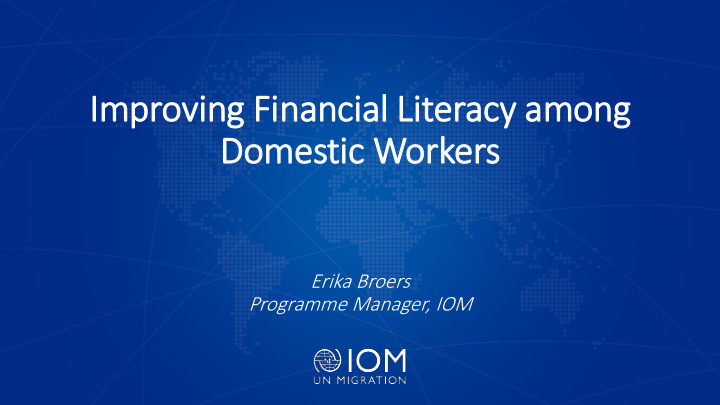



Im Improving Fin inancial Lit iteracy among Domestic Workers Erika Broers Programme Manager, IOM
Financial Literacy & TCWs Language barriers Global remittances have reached $689 billion access to The gender gap in financial literacy Low levels of associated financial financial literacy services Financial decision-makin g is no longer the sole domain of the male breadwinner Vuln lnerabili litie ies & & Women and girls often lack the essential life skills and Barriers Bar autonomy to make informed migration as well as financial decisions, in spite of their frequency in migrating, sending home and using remittances Safe and cost- effective lack of self- TCWs, particularly domestic workers, can face additional remittance confidence channels complications as they and the main remittance recipient are geographically separated, often for long periods of time. Mistrust of financial institutions
Examples of Challenges Provision of Financial Documentation Financial Financial Services Requirements Literacy Education Infrastructure • Unable to fulfil • Struggle to administrative understand terms and • Sessions are not • Lack of experience in requirements and features of different necessarily tailored to dealing with financial lack confidence in financial services and the needs of different institutions and seeking advice products groups of temporary formal products contractual workers
Financial Literacy and Orientation Policy makers are increasingly focusing on financial education as a tool to empower domestic workers to manage their finances effectively Seshan, 2015: Evaluating Financial Literacy Training for Migrant Workers in the Gulf
CIO IOP Pre-Departure Orientation ‘ Supports outgoing TCWs in preparing for their journey, adjustment period, life and work in the COD along with providing guidance on ways to get access to support channels and grievance mechanisms ’ Pre-Employment Orientation Post-Arrival Orientation ‘ Equips prospective TCWs with ‘ Provides TCWs with further accurate and tailored information to enable information regarding local labour them to make an informed laws, socio-cultural norms and decision on whether or not foreign practices, workplace expectations and employment is a realistic and good conduct ’ adequate option ’
CIO IOP and Financial Education I Pre-Departure Orientation ‘ Management of earnings and remittance ’ ↔ 1-2 hours ↔ tips on earning and remittance management ↔ saving action plans and budgets ↔ common challenges and remedies ↔ planning for the future Pre-Employment Orientation Post-Arrival Orientation ‘ Understanding basic financial ‘ Financial Management ’ management ’ ↔ correct modes of remittances ↔ ↔ 2 hours ↔ with family members ↔ national procedures and regulations key concepts ↔ healthy and realistic ↔ opening and maintaining bank financial expectations ↔ decision-making accounts ↔ saving responsibly ↔ process accounts for potential savings and recognizing financial scams cost ↔ financial division of labour
CIO IOP and Financial Education II II Provision of Financial Financial Services Documentation Financial Literacy Education Infrastructure Requirement Real-life samples and tools, such as Basic Financial Provision of relevant Tailored sessions remittance slips, salary Concepts information at PEO certificates, IEC material, simple budget and saving action plan samples Starts at PEO, benefitting family Gender Dimensions of members as well, Sufficient time to obtain Migration in PDO rendering more relevant documentation effective subsequent remittance and household financial management
Benefits of f Financial Literacy Financial literacy skills Orientation is vital for facilitates financial effective money management inclusion and long-term financial planning Sound financial decisions Domestic workers and their and behaviour can families need to be able to significantly improve effectively manage their financial wellbeing financial situation, income and expenses
Thank You Erika Broers ebroers@iom.int
Recommend
More recommend